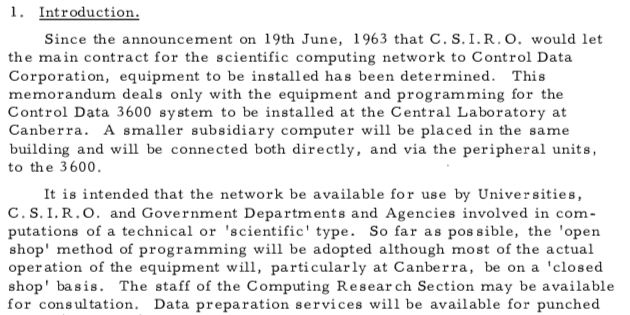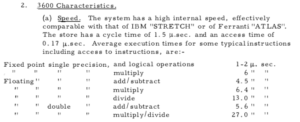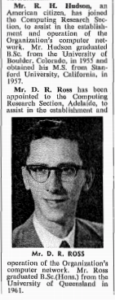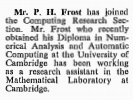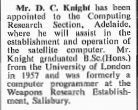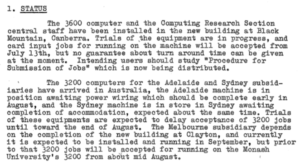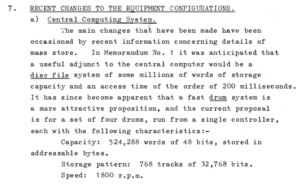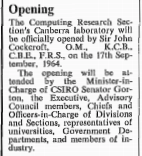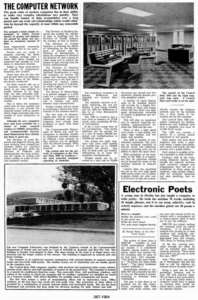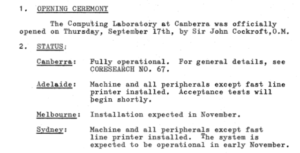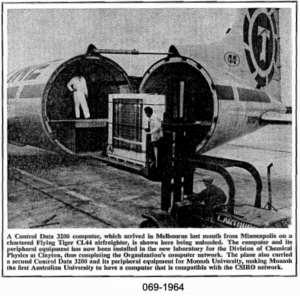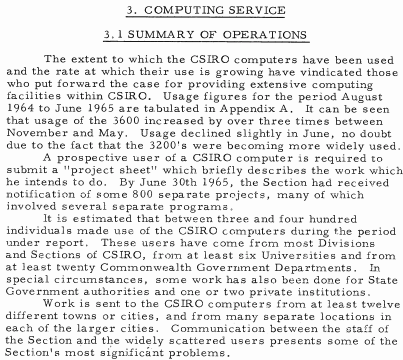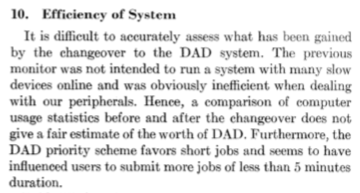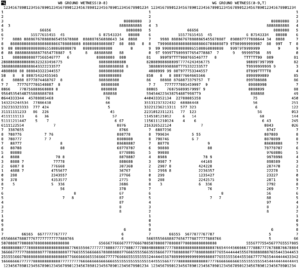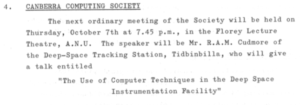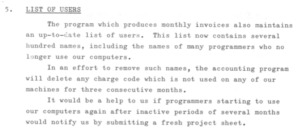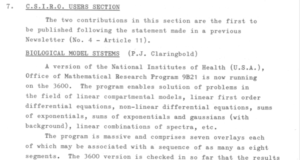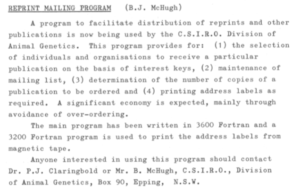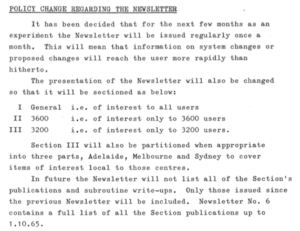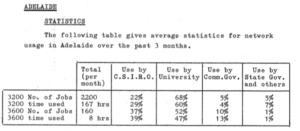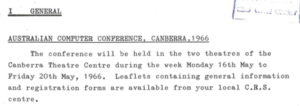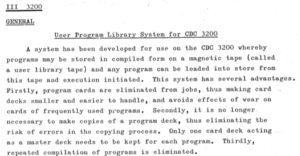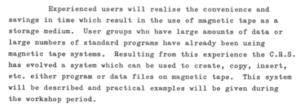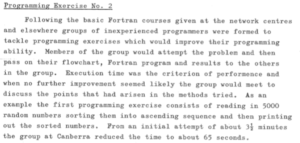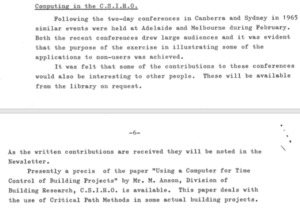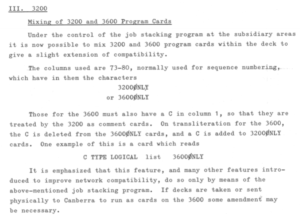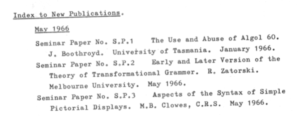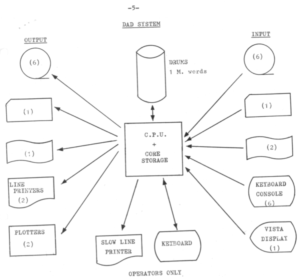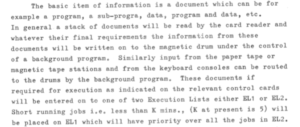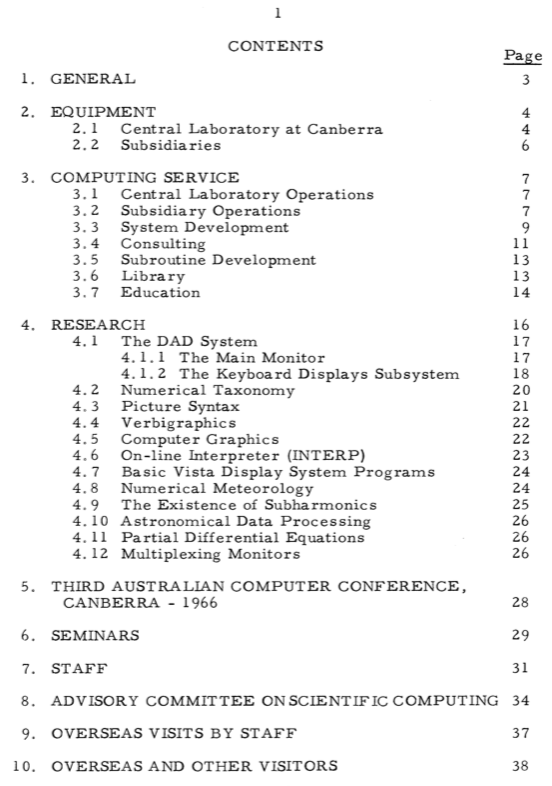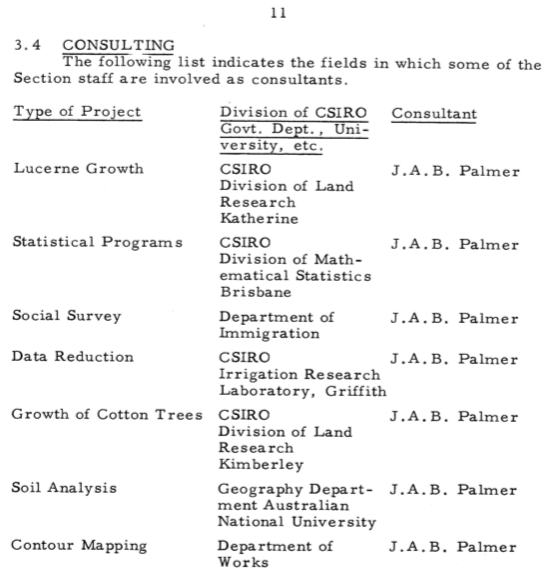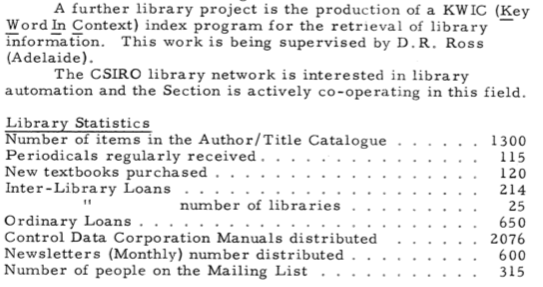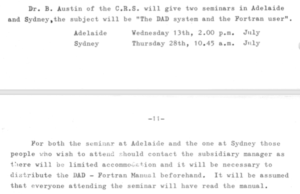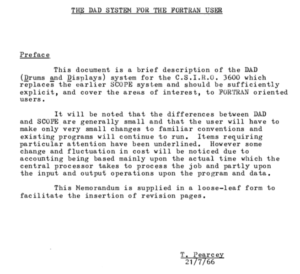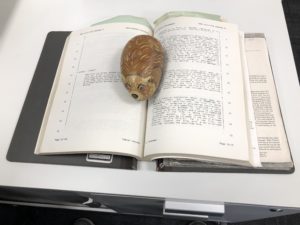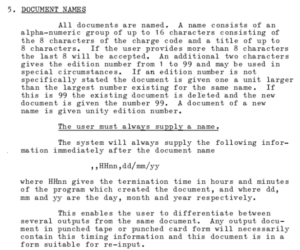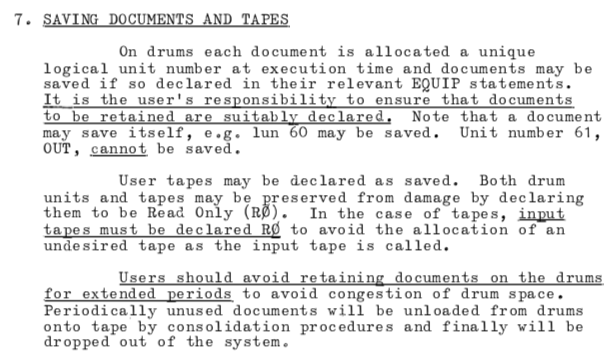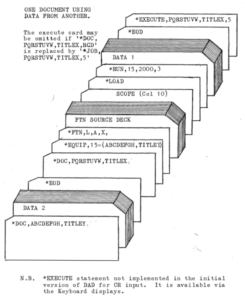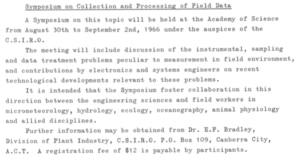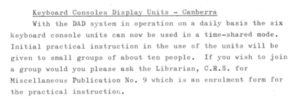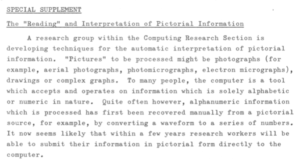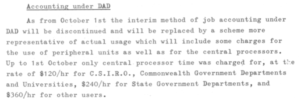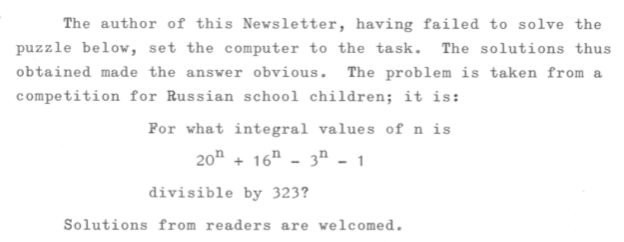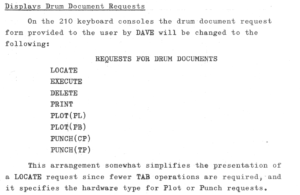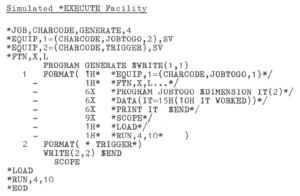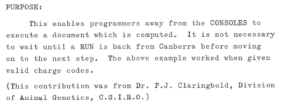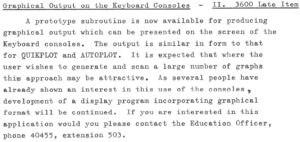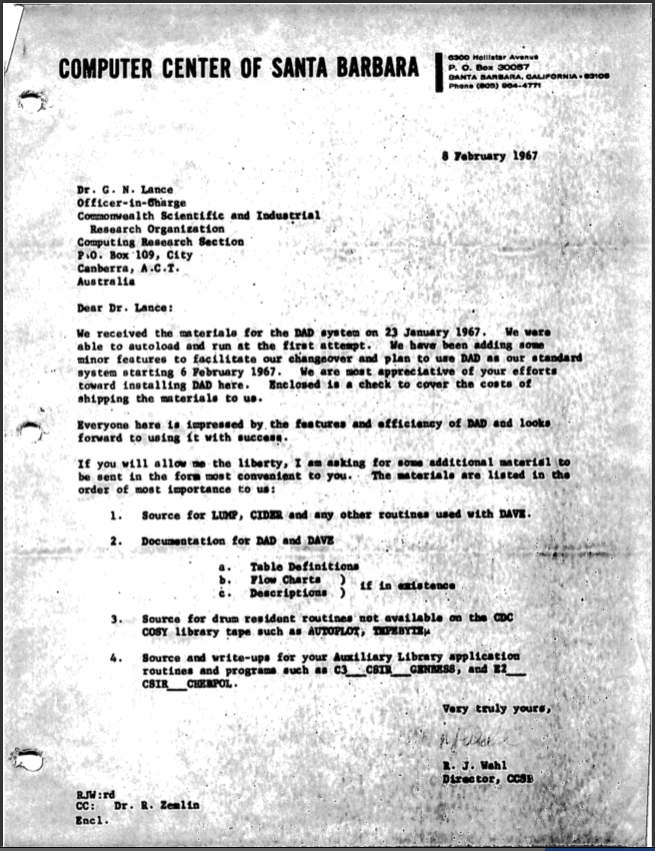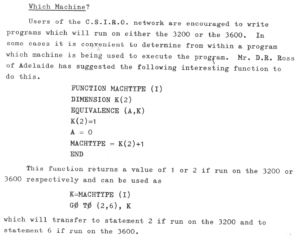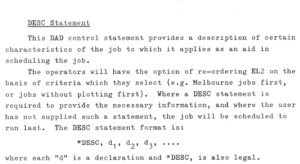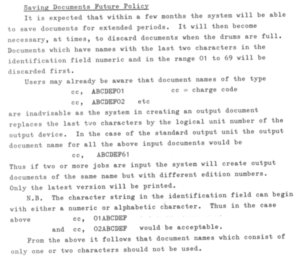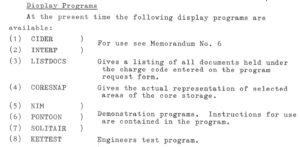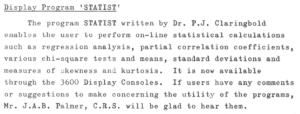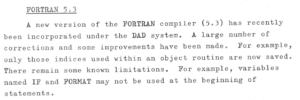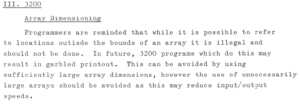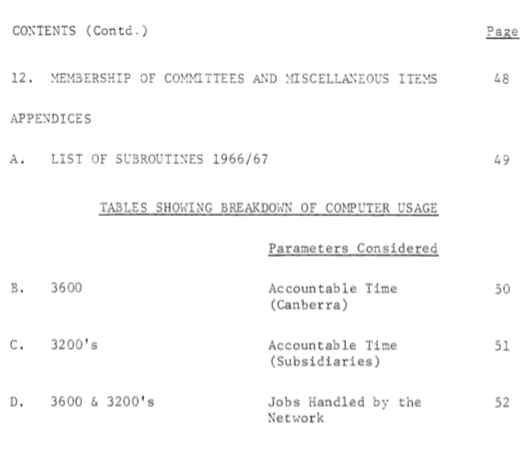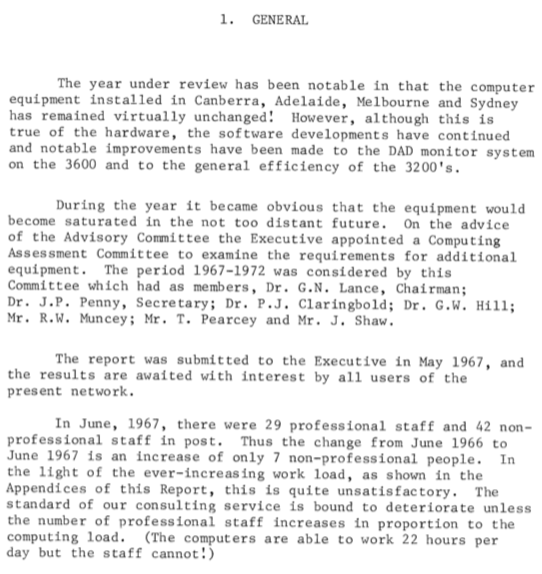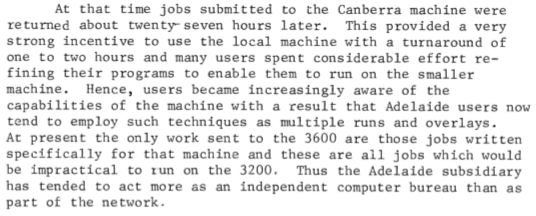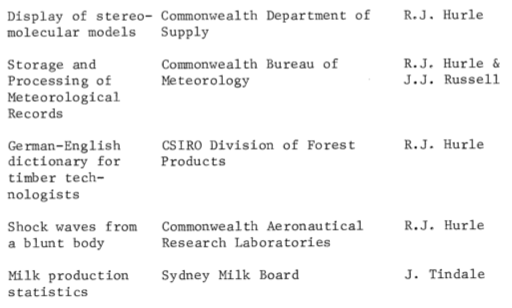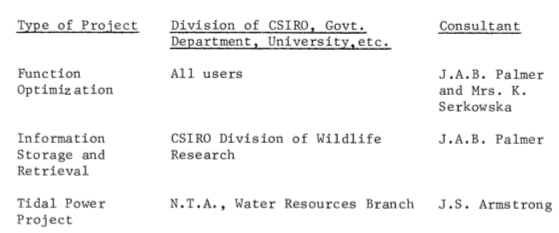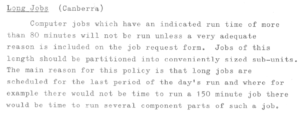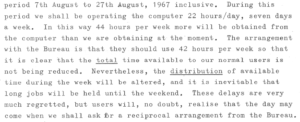CSIRO Computing History: Chapter 2
The establishment of the CSIRO Computing Network. 1962-67
Last updated: 19 Feb 2024 to add annotation to the 3600 picture.
14 Feb 2024: validating links
7 Sep 2022: added a link to a CDC ad for the 3600
24 Feb 2022: added more on the Bureau use of the 3600
18 Aug 2020: added SMH article on CDC contract
Robert C. Bell
previous chapter — contents — next chapter
Staff
Trevor Pearcey was on LWOP from 1 July 1957, and was seconded to the UK Ministry of Supply, and worked at the Royal Radar Establishment, Malvern, returning to Australia and commencing at the Division of Mathematics and Statistics on 10 March 1959, and was based at the University of Melbourne.
Geoffrey Hill transferred to DMS Adelaide in mid-1955, and was seconded to the University of Melbourne Computation Laboratory in 1957.
At this time, Trevor Pearcey was also involved with the development of the Cirrus computer at the University of Adelaide. Barbara Ainsworth reported (private communication January 2020):
The University of Adelaide was keen to develop a new computer centre in 1962 and Pearcey officially applied for the position of Director in May 1962. There was considerable discussion on the computing needs for the centre as well as the role of Cirrus and the potential of using computing power from the CSIRO’s new installation in Adelaide. While Pearcey was formally offered the position in December 1962, he ultimately did not accept. After some consideration, Pearcey declined the offer in May 1963, saying “In recent weeks however the situation has sufficiently cleared to enable me to decided that my real place, at least for the some period yet, lies with CSIRO where I can be best employed in helping to bring to practical fruition an idea for which I am some respects responsible.” Although he did not want the Directorship, Pearcey did want to continue working on the Cirrus project and felt that this should be a more formal arrangement.[i] The University officially requested Pearcey to be a consultant in July 1963, noting that he “has been actively interested in the computing research being undertaken in our Department of Electrical Engineering and Computing Centre, in particular in the design and programming of the CIRRUS computer”. He was officially released for 3 days every two months to work with the Adelaide team. Adelaide University paid for his costs and travel.[ii]
I think this is interesting as it shows his personal dedication to the new CSIRO network over possibly getting into academia. Pearcey had travelled to Adelaide for interviews, they had consulted John Bennett, this all took several months and then finally he said no!
Also interesting to read about the consideration of CSIRO’s direct interaction with the University and the possible role of the CDC in Adelaide once installed.
In July 1963, Pearcey, Hill, Terry Holden and John Penny were transferred to the Computing Research Section (Csironet News, no. 172, August 1983, p19).
C.S.I.R.O. Computing Research Section (CRS)
In 1962, a proposal from Trevor Pearcey with the support of E.A. Cornish from DMS for the establishment of a ‘network’ of computing facilities was approved by the CSIRO Executive and, through the Interdepartmental Committee on Automatic Data Processing (chaired by W. W. Gleeson of the Commonwealth Public Service Board, through which applications for ADP system grants were made), a £3 million grant (about $87M in 2018 values) was provided by the Commonwealth for the establishment of a Computing Research Section within the CSIRO. (Pearcey 1988). Note: £3 million was a very significant sum – CSIRO’s entire budget for 1963-1964 was £16 million, including industry funds.
Note: £3 million was a very significant sum – CSIRO’s entire budget for 1963-1964 was £16 million, including industry funds.
See also Trevor Pearcey CSIRO PH file at NAA: Trevor Pearcey CSIRO PH file at NAA
And, at NAA_ItemNumber11589410.pp125-126, is a letter from an Associate member of the CSIRO Executive, W. Ive, to Dr G. N. Lance about his appointment as Head of the new Computing Research Section, and his relationship with Trevor Pearcey, who was unsuccessful in his application for the position.
Late 1950s to early 1960s
-
Computing Research Section – CDC 3600 and CDC 3200s – DAD
CSIRO established a Computing Research Section on 1 January 1963: the McCann and Thorne book documents that Trevor Pearcey was working on the plan while at the University of Melbourne. Dr Godfrey Lance was appointed Officer-in-charge on 1 February 1963.
The contracts for the equipment and building were announced in CoResearch in July 1963 – see CoResearch no. 52 July 1963 and in newspapers such as this announcement from the Sydney Morning Herald.
CSIRO established a service in 1964 based on a CDC 3600 on Black Mountain in Canberra, and CDC 3200s in Melbourne, Sydney and Adelaide. CSIRO later had access to a 3200 in Brisbane run by the Bureau of Census and Statistics. Trevor (ET) Robinson who worked for E.L. Heymanson and Co. Pty. Ltd as the Australia agent for Control Data is reported to have told CDC management that he could sell 15 machines in Australia if CDC made a cheaper version of the 3600 – this was done, and became the lower 3000 series, including the 3200. (Recollections by E.T. Robinson (2004) – (Alan Bell, private communication November 2019) do indicate that the CDC bid to CSIRO and the Bureau of Census and Statistics did indeed tender satellite machines that were not only not announced by CDC, but were not in its plans.)
Here’s a picture of the 3600 consoles and peripherals – drum plotters, 7-track magnetic tape drives, a line printer and a paper tape device.
Peter Hanlon added the following:
The high-speed printers ran at about 2000 lines per minute, with a line length of about 130 characters. They printed from a 64-character set, consisting of upper-case letters, numbers and special characters including +, – , $, . and the characters such as ( ) , * / < > and space found in computer and spoken languages since Euler was a boy. It was a non-proportional font system. Wide characters such as W were sized exactly as skinny I.
The two Calcomp graph plotters were respectively 30cm and 90cm wide, ( or was it 1ft and 3ft) and had a pen up and pen down command, and 8 lateral movement commands which moved the pen one increment in the 8 major directions.
The paper tape units were mercifully lightly used, and DCR reserved one for its job accounting. One of the realities at the time was that the UK had continued to use paper tape for program development whereas the US had shifted to punched card, and Australia had followed them.
The Displays were channel-connected via a controller, using a 25 line X 40 character screen. The initial user software was a DCR/Control Data development called CIDER, and it had IBM TSO similarities.
The original plan was for the CDC 3600 in Canberra, and four subsidiary machines, one in Canberra to handle input and output, and one each in Adelaide, Melbourne and Sydney – see The scientific computing network 1. The Central Laboratory – CSIRO Computing Research Section, October 1963.
An extract from the contents give an outline:
- Introduction.
- Features affecting choice of the Control Data 3600.
- Main equipment
- Auxiliary equipment
- Character and code sets.
- The programming and operating system:
a) SCOPE.
b) FORTRAN 63.
c) COMPASS.
d) COBOL.
7. User’s organization – CO-OP.
8. Building.
Attachment. Control Data 3600 Computer System.
The Building was to be erected at Black Mountain, and was due to be completed in April 1964, with equipment to be installed in June 1964. It was to provide offices and a machine room.
Note that CSIRO was required to make the network available to like-minded organisations, and this continued through the life of CRS, DCR and Csironet.
Here are some details of the 3600:
Note that the execution times include all store (memory) accesses.
Here’s a comparison of CPU and memory speeds for the 3600 and a typical 2 GHz modern processor with DDR4.
|
Processor
|
Cycle time ns
|
Memory access time ns
|
Words per cycle
|
|---|---|---|---|
| 3600 | 1400 | 170 | 8 |
| Current | 0.5 | 12-15 | 0.04 |
| ratio (bigger is better) | 5000 | 12.5 | 0.005 |
Processor speeds have vastly improved, but the gain in memory performance is slow, and modern processors are quite unbalanced compared with the 3600.
The programming and operating system: SCOPE (Supervisory Control Of Program Execution) was the initial operating system, with Fortran, COMPASS (assembler) and COBOL to be available.
The memorandum contains plans for the building.
[NCAR installed a CDC 3600 in November 1963. ‘The CDC 3600 was a beautiful computer with smoked glass panels and a “solid and stunning” look. Seymour Cray had done much of the basic architecture design work on the CDC 3000 series systems.’ (https://www2.cisl.ucar.edu/supercomputer/3600) ]
See also the CDC advertisement on bitsavers that mentions CSIRO’s 3600.
The scientific computing network 2. The subsidiary systems – T. Pearcey, 28/11/63
“Each subsidiary system will consist of a recently announced Control Data 3200 computer”
“The three independently operating subsidiaries will be located at the following places:
(i) Adelaide – in the new Civil Engineering Annexe of the University of Adelaide.
(ii) Melbourne – at the C.S.I.R.O. Division of Chemical Physics building currently being constructed close to Monash University at Clayton,
(iii) Sydney – at the C.S.I.R.O. National Standards Laboratory in the grounds of the University of Sydney.”
The scientific computing network 3. Character and code sets – T. Pearcey, 23/4/64
These were huge issues in those pre-ASCII and pre-UTF days, with each vendor adopting different translations between internal and external representations.
Staff appointments started to appear in CoResearch – from CoResearch.no.61.1964-04.png, CoResearch.no.62.1964-05.png, CoResearch.no.64.1964-07.1.png, CoResearch.no.64.1964-07.2.png, CoResearch.no.65.1964-08.png. See below:
Rob Birtles from CSIRO Archives has uncovered a document giving the Procedure for the submission of jobs dated 22/6/64, by J.P. Penny. This details the forms to be filled in, including two copies, and shows the first job request card.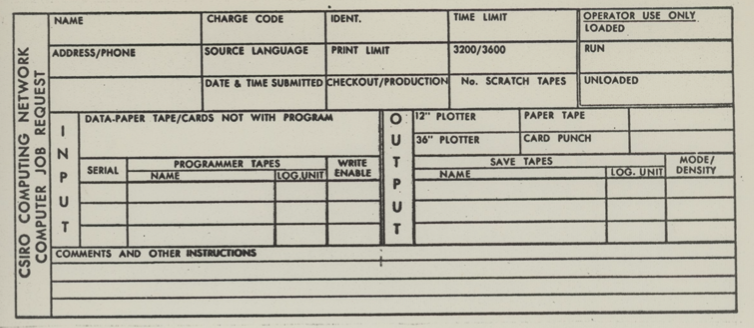
The first newsletter was dated 3/7/64, and attributed to Terry Holden, one of the pioneers who went on to become Assistant Chief of DCR.
C.S.I.R.O. Scientific Computing Network, Newsletter No. 1, 3/7/64 – T. S. Holden
Note that the building and 3600 installation were completed to the timetable announced. The plan was amended to drop the Canberra 3200, and to add to the 3600 a drum rather than the initially-envisaged disc storage, and to add visual displays, with Memoranda 1 and 2 dropped and replaced by Memorandum 4. Later, a disc store was added as well.
The scientific computing network 4. Revised equipment configurations – T.S.Holden, 31.7.64.
The list below gives an idea of what constituted a computing system in 1964. Note the memory sizes, and the size of the drum to come. Until that arrived, all the software was on tape: the compiler, the loader, the software libraries, etc.
Since a word on the 3600 was 48 bits (8 DISPLAY-code 6-bit characters, or six 8-bit bytes), total memory capacity was 32768 x 6 = 196608 bytes and the drum capacity was 4 x 5e5 x 6 = 12 Mbytes.
Here‘s a photo of the arrival of the Sydney CDC 3200.
Here are some of the changes from the initial proposal:
The drum access time of 17 ms is comparable to today’s disc drives – e.g. “Average seek time ranges from under 4 ms for high-end server drives, to 15 ms for mobile drives, with the most common mobile drives at about 12 ms and the most common desktop drives typically being around 9 ms.”, to which has to be added rotational delays of 2 to 7 ms (https://en.wikipedia.org/wiki/Hard_disk_drive_performance_characteristics). The transfer rate of 1.5 Mbyte/s seems very high for so long ago, and was 16 times the transfer rate of the fastest tape drive. I think the drum storage had a head for each track, so there was no seek time – only rotational delay.
The drum was the beginning of on-line storage for CSIRO.
The opening was announced in September 1964 CoResearch:
and highlighted on the front page in October.
More details were provided on page 2: see https://csiropedia.csiro.au/wp-content/uploads/2018/09/coresearch_1964.pdf
C.S.I.R.O. Scientific Computing Network – Newsletter No. 2 – 27/10/64
Sir John Douglas Cockcroft was a British physicist, and was chancellor of the ANU from 1961 to 1965.
CoResearch featured a picture of the arrival of the 3200 for Melbourne in the December 1964 issue:
the one for Monash University arrived on the same plane Flying Tigers plane, and is featured in a video made by Ron Bird at Delivery of Monash CDC 3200 system 1964 . (The CDC 3200 at Monash University was just over the road from CSIRO Clayton. It was originally installed in the Engineering buildings, but moved to the Computer Centre in 1969.)
There were clearly problems with the timely delivery of the 3200s, with problems with the software being revealed in a letter from November 1964 in Trevor Pearcey’s PH files at the NAA concerning a recommendation for overseas travel for Pearcey.
C.S.I.R.O. Computing Research Section – Newsletter No. 3 – 21/1/65
Note the change of name of the Newsletter.
This announced extended working hours, encouraging out of hours usage for development – a sign of things to come. 
C.S.I.R.O. Computing Research Section – Newsletter No. 2 extra – 28/4/65
This announced plans for Algol on the 3600 and 3200s.
(Fortran was widely adopted by U.S. manufacturers, but the Europeans favoured Algol. So, if you acquired a US-manufactured system, Fortran tended to arrive before Algol, and the ‘weed’ grew.)
C.S.I.R.O. Computing Research Section – Newsletter No. 4 – 8/4/65
It looks like the CDC 3200s were late.
This seems to be the first mention in newsletters of accounting, i.e. charging based on time and resources used. Presumably there had been letters from the CRS to Chiefs of Divisions announcing the charging regime. The charging policy became a fundamental flaw in the management of computing resources over the following decades.
C.S.I.R.O. Computing Research Section – Newsletter No. 5 – 25/6/65
It is interesting to see that a breakdown by the origin of the jobs was given for the 3600 in Canberra. Here’s a corresponding table of utilisation of the whole month of May 1965.
|
Percent
|
3200
|
3600
|
|---|---|---|
| Adelaide | 13 | 0.04 |
| Canberra | 21 | |
| Melbourne | 19 | 6 |
| Sydney | 10 | 6 |
| Total | 14 | 36 |
Utilisation of the 3600 for the operating hours of 12 hours per day for 21 working days was 105%!
This shows the beginnings of an outreach program, common to many HPC or scientific computing services, to show the benefits of computing to new fields: the beginnings of eResearch!
And, for those who needed to get the maximum from the system, a four-week course!
The first Annual Report was issued in 1965, and can be found here . Here is the contents page:
The preface noted that staff members’ names were not generally included, which is unfortunate.
Section 3 reported key figures to support the claim that these “have vindicated those who put forward the case for providing extensive computing facilities within CSIRO.” These were:
- a tripling of usage over recent 6 months
- 800 separate projects
- 300-400 users: from most CSIRO Divisions or Sections, six universities, 20 federal government departments, some state government authorities and two private institutions
- work originating from 12 towns or cities
There followed details of how users’ jobs were submitted and sent to the best system for processing, the timetables for courier runs for job dispatch and arrivals, with scheduling allowing one run per day on the 3600 for most users.
Section 4 described Research:
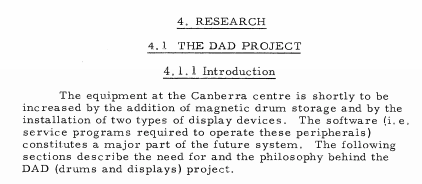 Details were then given on the SCOPE operating system then in operation on the 3600 and 3200s. The chief drawback was that it did one task at a time, so, for example, while reading the cards for a job (a slow process), the processor was largely idle, and again the processor was largely idle when printing the results from a job. DAD aimed to buffer all the slow input/output, using the drum, and so provide far higher throughput.
Details were then given on the SCOPE operating system then in operation on the 3600 and 3200s. The chief drawback was that it did one task at a time, so, for example, while reading the cards for a job (a slow process), the processor was largely idle, and again the processor was largely idle when printing the results from a job. DAD aimed to buffer all the slow input/output, using the drum, and so provide far higher throughput.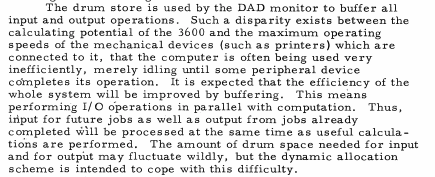
The 1967 CACM paper reported:
So, it was difficult to quantify the gains in throughput.
C.S.I.R.O. Computing Research Section – Newsletter No. 6 – 1/10/65
It would seem foreign to the modern generation to turn a graphical output into text, but this became a common way to quickly visualise results, and was far quicker than waiting for off-line plotter output. Later, people turned art work into pictures using line printers – over-printing, etc. Here’s an example of climate model output from the early 1990s:
It seems the service admits to only causing ‘obscure errors! This is the beginning of the whole software engineering issue of making changes for a good reason, but these having an impact on users, and the possibility of introducing errors. These issues have not gone away.
The CCS subsequently became a branch of the Australian Computer Society.
Here’s another issue that is still with us – registered users who no longer use the systems (or may have left the organisation). At least at this stage there were no on-line data holdings to clear up!
A new section appears in the Newsletter – user contributions, and the first is from Peter J. Claringbold, who went on to become Chief of the Division of Computing Research in about 1977, and the head of Csironet. The program he has ported is massive, with seven overlays. These are things the modern generation has never needed, and we would rather they never appeared again, but they were a means of reducing memory demands by dividing a large program into pieces that were executed sequentially, with only the currently executing piece being in memory.
Here’s the next contribution:
Here is the beginning of text processing, and Brian McHugh also joined DCR and worked in the systems team.
C.S.I.R.O. Computing Research Section – Newsletter No. 7 – 1/12/65
This is the beginning of a more rigorous information flow, necessary to keep users informed of changes to the facilities and services, although the flavour still seemed to be mostly that changes were made and the users told afterwards!
These figures show the extent to which the network was used predominantly by non-CSIRO users, particularly the 3200. Figures for the other states and Canberra were not published. Users from outside CSIRO were charged at a higher rate.
C.S.I.R.O. Computing Research Section – Newsletter No. 8 – 1/1/66 (I’m sure it wasn’t really published on this date!)
The Australian Computer Conference is announced. The first was held in 1951 at which CSIR Mk 1 was demonstrated.
Here is the beginning of the building of a library of code – apps these days. They had to be stored on tape, but this reduced the use of cards. The 3200s had no mass storage, though the Monash one did when I used it from 1968 onwards.
C.S.I.R.O. Computing Research Section – Newsletter No. 9 – 1/2/66
The distribution of this newsletter to over 1000 people illustrates the wide take-up of the services in the 20 months since inauguration.
I’ll omit commentary on the item about the use of official telegrams!
This is further evidence of the trend to use magnetic storage rather than cards, and to bring the data and programs closer to the system.
C.S.I.R.O. Computing Research Section – Newsletter No. 10 – 1/3/66
No-one seems to use flowcharts anymore, though Fortran survives!
The timing is extraordinarily slow, even for those times. Maybe something like quiksort was not available. This reminds me of a story about Don Knuth. One of his students wrote a program which required some sorting, and the student used a straightforward but inefficient method. Don reportedly inserted in the code the comment “Don’t let me catch you using this algorithm ever again!”.
It looks like the awareness conferences worked well.
It is interesting to see the early use of the computer for a non-numeric application.
C.S.I.R.O. Computing Research Section – Newsletter No. 11 – 1.4.66
This signals progress in the implementation of DAD, to allow the use of the Drums And Display.
It seems that already some users were subverting the system, in the face of the charging regime!
Following this was information and a table about the length of tape needed to write a record of 256 words (48 bits each, so 2048 6-bit characters or 1536 8-bit bytes) at various densities (from 3.31″ to 23.74″ including the inter-record gap of 0.75″). The worst case showed only 14% efficiency compared with the best usage. Users needed to know about tape hardware, and had to manage their own usage of tapes.
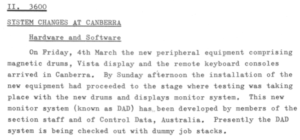
The new hardware had arrived, which would begin the era of on-line digital storage for CSIRO. In those days, a small team could write a monitor (operating system), although I suspect it drew on the code in the CDC SCOPE system with the collaboration of CDA staff.
This was not CSIRO’s first live demonstration, since Trevor Pearcey demonstrated CSIR Mk 1 at the 1951 conference.
Charles Johnson was a major contributor to CSIRO scientific computing, through to the Supercomputing Facilities Task Force in 1989. John Paine went on the play major roles in Csironet.
This illustrates the measures taken to minimise the system memory requirements to allow greater use by users, particularly for the 3200s, which had only 16,384 24-bit words, i.e. 49152 bytes!
This is another example of conserving store (memory). It also illustrates a pioneering feature of the 3000 series machines and the Fortran compilers – the ability to support extended types, and to generate code to use these. This one was a special floating-point format. Others included a type matrix, allowing Fortran statements like A = B * C + D, where all of A, B, C and D were matrices, and anticipating the Fortran 90 array capabilities, and the extended types of other languages from the 1970s. Another type allowed for interval arithmetic, which was useful for providing error bounds on results. Someone once said that one measurement or value doesn’t tell you anything!
C.S.I.R.O. Computing Research Section – Newsletter No. 12 – 1.5.66
This was a lightweight newsletter, as there was probably a lot of activity preparing for:
CRS was still working towards a unified network, and the above illustrates a first approach to conditional compilation, using the job-stacking program which would now be called a preprocessor to a language. Maintaining multiple versions of code for different environments is an on-going problem.
C.S.I.R.O. Computing Research Section – Newsletter No. 13 – 1.6.66
Many of these staff members went on to long careers with CRS/DCR/Csironet. It would have been good to have a list of Canberra staff as well, but these will be in the records.
This is a pretty interesting list. Even Algol could be abused, and this was before the time of Edsger Dijkstra’s famous “Go To Statement Considered Harmful” letter published in the March 1968 CACM. The second paper indicates early use of computers for non-numeric applications and the application to processing of grammars for both computer and natural languages. The third indicates early work on visualisation systems.
If you are old enough to have used Fortran prior to the introduction of structured programming support in Fortran 77, you may remember or have been responsible for code which could have used this program from Peter Ewens, who subsequently joined the systems team at DCR.
DAD had arrived! It was not just the addition of drums and displays, but the introduction of time-sharing!
(The unlabelled icons are for cards and paper tape).
Documents became a general term for any stored information. The drum acted as a buffer between input, processing and output, and no doubt greatly added to the throughput.
And, a priority scheme was introduced, with two queues, with one having absolute priority over the other – a crude but first scheme often employed: many scheduling systems still use queues with some queues having absolute priority over others: it works for a while, until the high priority queue gets flooded leading to zero throughput for the other queues. Banks had personal and business queues for tellers for example.
The queuing system was smart enough to deal with dependencies on data being available, and selected only jobs ready to run. This type of scheduling would still be valuable, and can be achieved with batch systems that cater for file staging. Note that there was a similar splitting of output requests into low and high priority, based on size. Again, crude, but better than no prioritisation, like being stuck in a bank teller queue behind the person lodging the weekend’s school fete takings!
Here is the key development – overlapping of input, processing and output. The interrupt system and the intelligent channel processors enabled most of the input/output work to be offloaded from the main processor.
Here is the beginning of two vital concepts – the storing of information in ‘permanent’ on-line digital storage, and interactive access to documents and processing power: both concepts are now so mainstream we barely think about them!
The 138 pages in the DAD Technical Design Papers.pdf in the Terry Holden collection contain details of the DAD development, and include Judith Wright’s poem, Computers.
The 1965-1966 Annual Report can be found here. Here are the contents pages:
The drum storage was reported as consisting of two units, rather than the four units proposed earlier.
Section 3 of the report addressed the computing service. 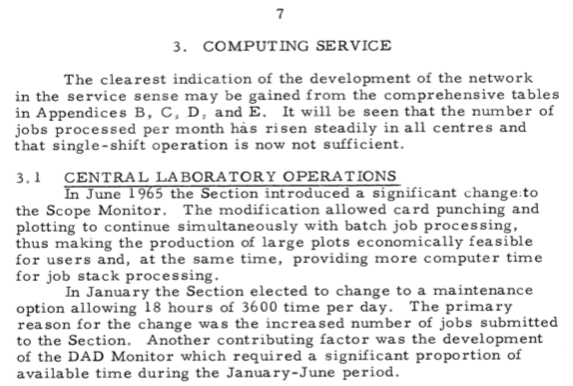 The first paragraph highlighted the growth in usage – Appendix B shows roughly double the usage of the 3600 in this financial year compared with the previous year. The second paragraph highlighted a change to the SCOPE monitor, allowing multiplexing of card punching and plotting: this anticipated the more general solution to be provided by DAD. The third paragraph noted the operating times of the 3600 being increased to 18 hours per day, primarily because of demand.
The first paragraph highlighted the growth in usage – Appendix B shows roughly double the usage of the 3600 in this financial year compared with the previous year. The second paragraph highlighted a change to the SCOPE monitor, allowing multiplexing of card punching and plotting: this anticipated the more general solution to be provided by DAD. The third paragraph noted the operating times of the 3600 being increased to 18 hours per day, primarily because of demand.
The Consulting section under Computing Service highlighted the range of applications being run – here are the projects from just one staff member (there were 33 projects listed)
The Library section highlighted the development of a computer-based system for the distribution of publications, as well as the development of a KWIC system, the start of CSIRO library automation, and statistics on the library operations.
Distribution of manuals was a major undertaking, in the days before such material could be on-line.
The Research section highlighted both systems and applications research, particularly the DAD project.
Here is a picture of the keyboard console from the Research section.
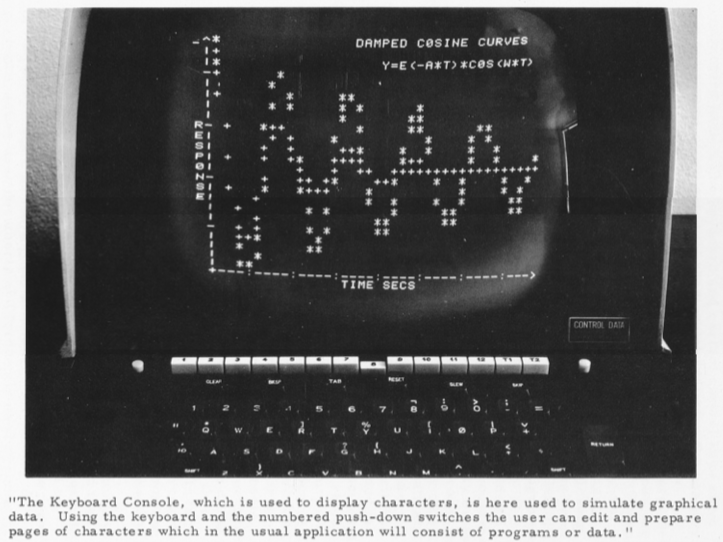 Under the sub-section Numerical Meteorology, the graphical display screen was pictured.
Under the sub-section Numerical Meteorology, the graphical display screen was pictured.
C.S.I.R.O. Computing Research Section – Newsletter No. 14 – 1.7.66
As often happens, two versions of critical software need to be run for some time to allow for conversion. The “DAD Programmers’ Manual”, (Memo No. 5) may be an earlier name for the “THE DAD SYSTEM FOR THE FORTRAN USER” which is accessible below.
The newsletter then contained sections on Control Statements (differences between systems), Magnetic Tape Labels, Facility Restrictions (addressing features not yet available), and Accounting:
The accounting capabilities are carried forward to DAD, with a greater grasp!
Reading the manual – what a novel concept, but it used to happen! Brian Austin went on to head the systems team in DCR.
The scientific computing network 5. The DAD system for the Fortran user – T. Pearcey, 21.7.66, Edition 1
Trevor Pearcey’s name re-appears, and we assume that he had been working on the DAD project for two years, along with several others. The publication is 36 pages.
CSIRO CRS follows CDC’s lead in making provision for revision pages to be inserted. Typically, manuals were put into three-ring binders, to allow pages to be updated, and preferably using Chicago bolts, to stop frequently-used pages getting mangled. A rounded rock was useful to keep the manual open at the current page of interest!
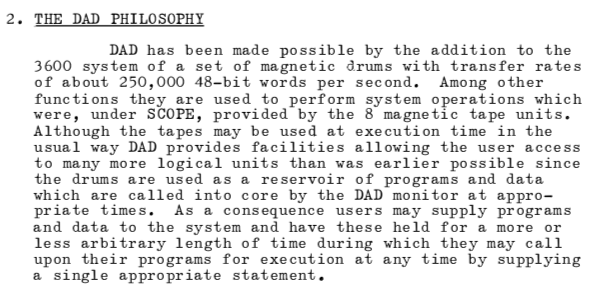 The Memorandum no.4 lists four drum units, each with 524,288 48-bit words and each capable of transferring 250,000 words/s. This leads to a total capacity of 12.6 Mbyte and a transfer rate of 6 Mbyte/s, so the whole device could be read or written in a little over 2 seconds! Modern discs take half a day to read or write the entire contents! (12 Tbyte capacity, maximum data rate 245 Mbyte/s https://www.scorptec.com.au/product/Hard-Drives-&-SSDs/HDD-3.5-Drives/73656-WD121PURZ?gclid=EAIaIQobChMI8J_PjbTy4gIVCiUrCh3-owMsEAQYAyABEgIcXPD_BwE).
The Memorandum no.4 lists four drum units, each with 524,288 48-bit words and each capable of transferring 250,000 words/s. This leads to a total capacity of 12.6 Mbyte and a transfer rate of 6 Mbyte/s, so the whole device could be read or written in a little over 2 seconds! Modern discs take half a day to read or write the entire contents! (12 Tbyte capacity, maximum data rate 245 Mbyte/s https://www.scorptec.com.au/product/Hard-Drives-&-SSDs/HDD-3.5-Drives/73656-WD121PURZ?gclid=EAIaIQobChMI8J_PjbTy4gIVCiUrCh3-owMsEAQYAyABEgIcXPD_BwE).
This extract also confirms that system functions under SCOPE were done on the magnetic tapes – e.g. compilers and loaders.
Documents have names, and are record-oriented.
I suspect the i/o caused interrupts, but only to initiate transfers.
Here is the beginning of the concepts of specifying that documents are to be retained, not just spooled; and a first caution arises about congestion or contention between users for space on a shared storage resource, an un-solved problem for many systems and centres.
Given that the drum was the first random-access permanent storage, it is perhaps not surprising that users were given random access services for the first time. Subroutines had to be called.
Document name restrictions turned out to be very important in the history of computing. Many will be pleased not to remember the DOS restrictions of 8-character names and a 3-character extension.
(Later the CDC Cyber 76 SCOPE 2 system at CSIRO had a 40-character file name limit, which was generous, but severely restricted the number of files able to be kept. DCR staff adapted the subroutine libraries to allow interactive access to text documents (in a partitioned dataset in IBM terminology), but the partition names were restricted to 7 characters! Serendipitously, the staff made provision for a 70-character comment, which turned out to be the best metadata capture in years.)
The notion that only the last 8 characters of any long name would be used turned out to be a bit dangerous. Note that edition numbers were provided, which is an important concept not generally supported in current UNIX/Linux file systems. And, dates and times were attached to the documents, so that they had:
- an owner
- a name (of up to 8 characters)
- a creation date/time
- an edition number
which is not bad for starters.
This is a repeated warning about congestion, with the addition of a warning about dropping old documents – flushing in current terminology. It reads like an intention at this stage, rather similar to what many HPC sites currently state but don’t carry out.
There are extensive sections describing all the command lines available, e.g. DOC, JOB, EQUIP, FTN, LOAD, RUN.
Finally, here is an example job:
C.S.I.R.O. Computing Research Section – Newsletter No. 15 – 1.8.66
This is an example of the spread of computing out of the machine room and into the thinking about field data.
DAD documentation and education was being rolled out.
This was the beginning of interactive access – at this stage, the only consoles were at the Computing Research Section in Canberra.
Examples were given – the analysis of chromosome micrographs, and drainage net deduction from pairs of aerial photographs.
C.S.I.R.O. Computing Research Section – Newsletter No. 16 – 1.9.66
There were more compatibility requirements.
C.S.I.R.O. Computing Research Section – Newsletter No. 17 – 1.10.66
Accounting for usage under DAD was changed.
Note the different rates for different organisation classes.
Every component of usage was aimed to be covered by charges!
The charge of 0.384 seconds per drum sector for storage worked out to be $7.50 per Mbyte. There was no duration on the charge – it was just charged as part of the job for using the space.
There was even a charge for the use of the DELETE command!
The scientific computing network 6. C.S.I.R.O. on-line system, user’s guide – T. Pearcey, 1.10.66
CSIRO developed its own operating system for the 3600 called DAD, for Drums and Display. Later subsystems were called MUM (Multi-User-Monitor, running on a PDP-8), DAVE and MABEL, references to Steele Rudd’s characters in “On our Selection” – books, and also a serial on the radio from 1937 to 1953. A paper with Brian Austin as lead author was published in 1967 in CACM – see DAD paper.
Job submission was mostly by card decks, sent by courier (once or twice per business day) to the local or remote systems, with the job output (11” by 15” fan-fold paper) returned wrapped around the card deck and secured by another rubber band. Jobs for the 3600 were copied to magnetic tape and air-freighted to Canberra. See the CSIRO 1967 film on classification – includes the CDC 3600 at Computer Research Section – here https://www.scienceimage.csiro.au/video/11736/classifying-by-computer/
The on-line system allowed for interactive development, visualisation and steering of programs.
C.S.I.R.O. Computing Research Section – Newsletter No. 18 – 1.11.66
Access to the VISTA displays from Fortran programs was announced.
Artificial Intelligence was a topic under consideration in 1966!
Newsletter 18 contained the first of a series of puzzles.
C.S.I.R.O. Computing Research Section – Newsletter No. 19 – 1.12.66
Here is another new concept – ‘output’ being able to be saved and viewed on-line from a console rather than automatically printed and the on-line copy discarded.
(The SCOPE and DAD operating systems used the concept of logical units for i/o, which were core to Fortran. The card reader was on unit 60, and output for printing was on unit 61.)
A default time limit of 1 minute was imposed on jobs running under DAD. I guess this change was used to entice users to set a realistic time limit.
The locate request allowed documents to be found – an audit or listing capability. The display capability was fairly limited in its ability to work with saved documents on the drum, as shown by the commands above, but the CIDER command allowed inspection and editing.
This newsletter also contained an example program to implement dependencies and to allow programmers away from the console to execute a document. It shows a program which generates another program! Here is the start of the item:
…
The contributor was none other than the future Chief of DCR, Peter Claringbold.
Finally, another key capability became available – graphical display.
Of course, at this stage, the capability was available only on-site in Canberra.
The Papers of Terry Holden (see references) contain the following letter:
This is a triumph – an operating system being exported from Australia to the US, and working first time, and being adopted into production!
It’s possible that this is the first recorded export of software developed in Australia.
C.S.I.R.O. Computing Research Section – Newsletter No. 20 – 1.2.67
Once you have more than one system, trying to write programs that work on different machines becomes important, and a key capability of modern development environments. Here is the first recorded attempt to allow CSIRO users to distinguish between running on the 3600 or a 3200.
[How does it work? On the 3600 reals and integers were 48-bit, whereas on the 3200s, integers were 24-bit. So the equivalence statement maps a real (A) to two (integer) words on the 3200 and to one (integer) word on the 3600. So, the statement A=0 alters the value of K(2) on the 3200, but not on the 3600. The code relies on floating point zero having the same representation as integer zero with all bits being zero!]
Correct scheduling of jobs usually requires users to specify the resources required by the job – we saw time limits being addressed in the previous newsletter. Now, with the DISPLAY capability using some of the 3600 memory, less was available for jobs. A new command to help with scheduling was introduced.
EL2 was the low-priority execution queue. Note the incentive to users to use the new capability!
I like the mention of honesty!
The description is fairly tortuous, but seems to be designed so that by default, jobs would run with the DISPLAYs were enabled.
Finally:
This indicates the growth of out-of-hours working by users, in order to get access to the DISPLAY facilities.
C.S.I.R.O. Computing Research Section – Newsletter No. 21 – 1.3.67
This newsletter announced the first capability in CSIRO for saving data on-line.
Charging was set in advance: $108 per hour for compute, $7.50/Mbyte/day.
Here is a list of the DISPLAY programs available – note the presence of three computer games!
C.S.I.R.O. Computing Research Section – Newsletter No. 22 – 1.4.67
This short newsletter included what had become standard in each issue – a list of publications issued during the month, and a list of courses. There was a note that “As the demand for the last Compass course was unexpectedly high, it is planned to hold another two day course in May.” COMPASS for the assembler for CDC systems.
Here’s the header from an example printout from a job run on DAD. (This was a job run by my sister Margaret in the early days of her work with the Bureau of Meteorology).
C.S.I.R.O. Computing Research Section – Newsletter No. 23 – 1.5.67
The application of computing was widening:
(TV apparently wasn’t widely networked – the videotapes had to be sent from state to state!)
Peter Claringbold continued to innovate:
C.S.I.R.O. Computing Research Section – Newsletter No. 24 – 1.6.67
A new version of the Fortran compiler was announced, but judging by the last sentence below, its basic parsing was flawed!
There were a lot of things you could do with early versions of Fortran which were not a good idea, and are hard to do with modern Fortran.
The 1966-1967 Annual Report can be found here. The title page contained: which shows that the report was not published until August 1967 or later, as is typical for annual reports.
which shows that the report was not published until August 1967 or later, as is typical for annual reports.
This highlights plans for expansion (not acted on for another 5 years), the growing demand for computing resources, and the pressures on staff. Insufficient staff numbers continued to be highlighted for the next ten years or so!
The Computing Service section started with
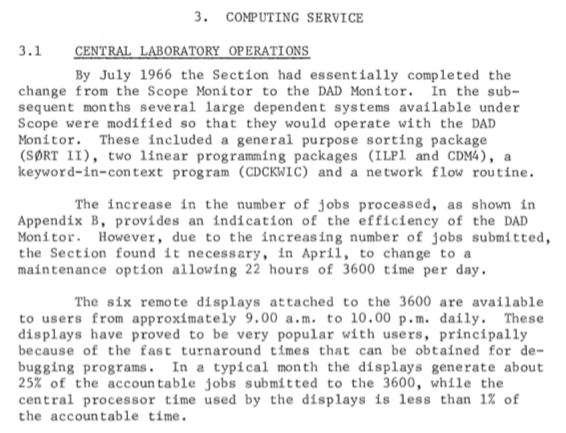 The first section highlights the problem caused when building a bespoke operating system – the porting of packages. Peter Hanlon (Private communication, 2019) reported that he spent a considerable time porting one package (to be confirmed)! Almost full-shift operation was commenced.
The first section highlights the problem caused when building a bespoke operating system – the porting of packages. Peter Hanlon (Private communication, 2019) reported that he spent a considerable time porting one package (to be confirmed)! Almost full-shift operation was commenced.
The increase in the number of jobs was 45% compared with the previous year, with the main increase coming on the 3600 from Canberra users – a doubling – reflecting perhaps the ease of use using the display terminals, which is highlighted in the third paragraph.
Under the Subsidiary Operations section: The 6400 was a later architecture than the 3600, and a smaller version of CDC’s flagship 6600. I guess Cirrus was then displaced, assumed it had been in production. The following gives some insight into the practicalities of the network: adapting to slow turnaround on a major system, with faster turnaround on a smaller local system. This pattern continues today in HPC.
The 6400 was a later architecture than the 3600, and a smaller version of CDC’s flagship 6600. I guess Cirrus was then displaced, assumed it had been in production. The following gives some insight into the practicalities of the network: adapting to slow turnaround on a major system, with faster turnaround on a smaller local system. This pattern continues today in HPC.
And, in the extreme, a link to NZ provided a 3-day turnaround!
Under the heading Systems Development, the impending arrival of discs at the subsidiaries was noted.
Under the heading “Consulting”, a very wide range of projects were listed (48 in total), including from universities and government departments, with the Sydney Milk Board and the RAAF being noted. Here is a sample, including the beginnings of the Bureau of Meteorology’s use of computers:
During 1966-67, the Bureau commenced the development of Numerical Weather Analysis and Prediction systems using the 3600 (Maine, 1968), prior to the acquisition of its first mainframe computer, the IBM 360/65, in 1968.
Here are the last three consulting items:
The project on tidal power anticipated similar projects in operation 40 years later!
Under the Research section, the further development of DAD to encompass disc storage was outlined.
 Trevor Pearcey continued pioneering research:
Trevor Pearcey continued pioneering research:
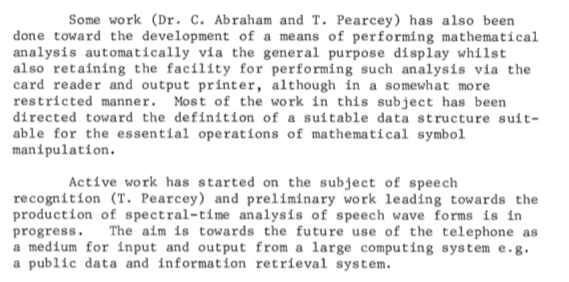 Speech recognition was being targetted nearly 55 years ago!
Speech recognition was being targetted nearly 55 years ago!
And, here is more about meteorological research:
C.S.I.R.O. Computing Research Section – Newsletter No. 25 – 1.7.67
Scheduling issues arose early in the life of the systems, as demand exceeded supply.
This newsletter included an article on “Optimizing Production Programs”, and included points to help users improve their programs.
C.S.I.R.O. Computing Research Section – Newsletter No. 26 – 1.8.67
This newsletter contained an article on the “Storage and Transport of Computer Media”, e.g. punched cards, paper tape.
It also included an announcement that was not going to help the throughput!
CSIRO did subsequently gain access to a Census and Statistics 3200 in Brisbane.
C.S.I.R.O. Computing Research Section – Newsletter No. 27 – 1.9.67
Increased on-line storage was the big news – discs for the first time. Four million 6-bit characters each for the 3200s, and 100 million 6-bit characters for the 3600.
![]()
Foreshadowed was making available about 10 million characters of space for all the users – not for each!
And, here is the beginning of the FLUSH process for managing a shared region, and the beginning of a Hierarchical Storage Manager, with documents from the drum being copied to magnetic tape and later able to be restored to the drum. This was pioneering work again!
It seems that there was an easy purge process in place – the contents of the drum were lost overnight!
A presentation on the beginnings of tiered storage in CSIRO is available in the Resources Section under the title “Pre-history: the origins of HSM in scientific computing in Australia”. This contains snippets from DCR Newsletters from 1966 to 1980.
Newsletter 28 announced the change of name from Computing Research Section to the Division of Computing Research (which happened on 28 August 1967) with Dr G. N. Lance appointed Chief of Division, which brings to a close this chapter on the Computing Research Section and the establishment of the C.S.I.R.O. Computing Network.
We saw:
- the setting up of a service, with budget, staff, equipment and buildings established
- the concept of a network, with multiple machines linked
- the introduction of on-line digital storage (drums and disc)
- the introduction of interactive usage, including graphical display
- the development by CSIRO and CDA of an operating system to support the Drums and Display (DAD)
- the beginnings of scheduling issues
- the emergence of the use of computers in an ever-widening range of fields
- the beginnings of shared storage management, flushing, and HSM.
Note: this chapter is close to complete as far as the Computing Research Section Newsletters and Annual Reports of this period disclose.



